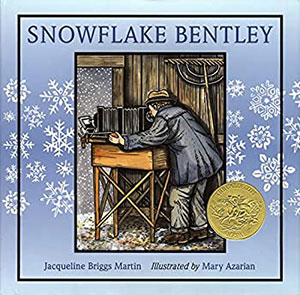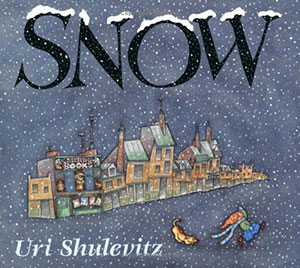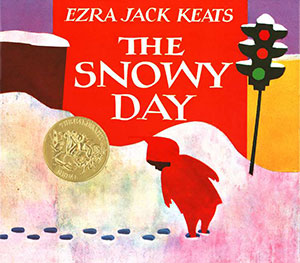In the far reaches of the northern hemisphere, snow graces the winter landscape and shapes the activities of the season. Even children who live in milder climates are familiar with the concept of snow. Picture books set in winter typically feature snowy backdrops and this column takes a look at five Caldecott Award-winning snow stories.
In 1999, the Caldecott Committee recognized two snow-themed books. Receiving the Caldecott Medal was Snowflake Bentley, a nonfiction work that melds science and art. Written by Jacqueline Briggs Martin and illustrated by Mary Azarian, this picture book biography of self-taught scientist Wilson Bentley introduces readers to “a boy who loved snow more than anything else in the world.” Growing up in rural Vermont in the latter half of the 19th century, Willie is a teen when his parents go to great expense to buy him a special camera with a microscope so that he can photograph snowflakes. Through trial and error, Bentley hones his technique until he jubilantly captures snowflakes on film. His book of snowflake photographs, still in print today, was published a month before his untimely death in 1926.
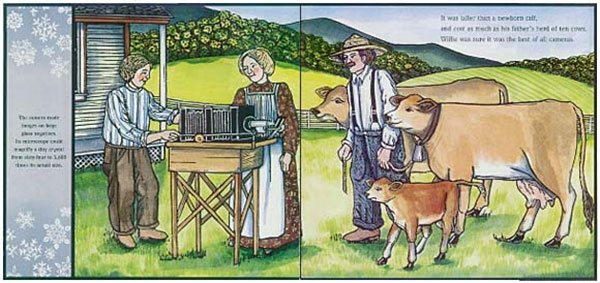
Written by Jacqueline Briggs Martin. Published by Clarion Books, 1998.
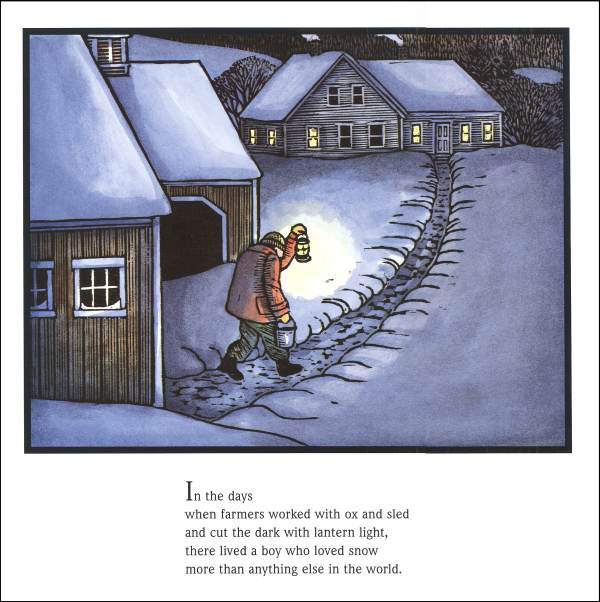
Written by Jacqueline Briggs Martin. Published by Clarion Books, 1998.
Azarian’s woodcuts, hand-tinted with watercolors,1 have the staid, formal look of folk art appropriate to the setting of the story. Strong horizontal lines dominate, creating a sense of stability, while judicious diagonal lines add subtle energy to the illustrations. Thick woodcut outlines reflect Bentley’s resolute spirit. Most spreads incorporate one or two sidebars, providing additional information about the man and his work. Consider pairing this book with Bentley’s Snowflakes in Photography for a deeper understanding of the man’s contributions to science and photography. (Read more about this book in our article, “Visual Artists, Part I.”)
In the 1999 Caldecott Honor book Snow, author-illustrator Uri Shulevitz focuses on a determined, joyful child, who is certain that snow is coming, despite skeptical and dour adults around him. “Boy with dog” prances through an Eastern European town with crooked buildings, where neutral tones dominate in the line and watercolor washes.2 Flake by flake, the town is transformed as the dreary becomes magical. Indeed, even Mother Goose, her namesake companion, and Humpty Dumpty join the boy and his dog in a celebration as thick snow falls.
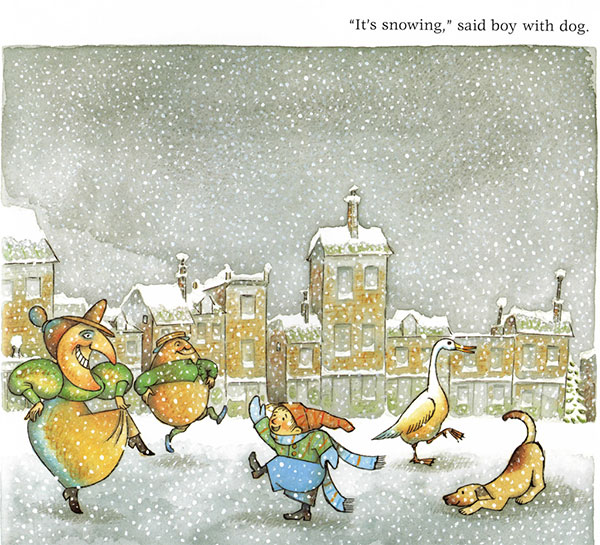
Varying page designs, text placement, and use of partial-bleed illustrations keep the reader engaged, while Shulevitz’s cartoon style adds whimsy. The interior scenes in golden hues contrast with the cool exterior scenes. In the final two spreads, “The whole city is white” against a brilliant blue sky, while the boy and dog provide a welcome splash of color.
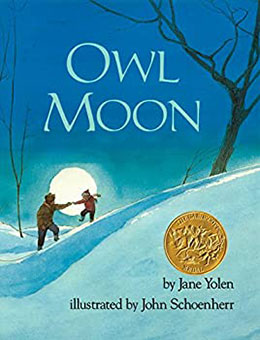 Moving from city to countryside, the 1988 Caldecott Medal book Owl Moon transports readers to the snowy woods, where a child and father venture out at night in search of a great horned owl. Author Jane Yolen’s poetic text sets the stage for the outing and creates anticipation while John Schoenherr’s realistic pen and ink and watercolor illustrations3 establish the mood and heighten the drama. With a limited palette of blue, white, brown, and grey, the artist triumphs over two challenges: conveying details of a nighttime excursion lit only by a full moon and occasional beams of a flashlight, while capturing the beauty of the vast snowy terrain. In many scenes, Schoenherr uses white space to suggest snow on the full-bleed double-page spreads; moon shadows define the landscape.
Moving from city to countryside, the 1988 Caldecott Medal book Owl Moon transports readers to the snowy woods, where a child and father venture out at night in search of a great horned owl. Author Jane Yolen’s poetic text sets the stage for the outing and creates anticipation while John Schoenherr’s realistic pen and ink and watercolor illustrations3 establish the mood and heighten the drama. With a limited palette of blue, white, brown, and grey, the artist triumphs over two challenges: conveying details of a nighttime excursion lit only by a full moon and occasional beams of a flashlight, while capturing the beauty of the vast snowy terrain. In many scenes, Schoenherr uses white space to suggest snow on the full-bleed double-page spreads; moon shadows define the landscape.
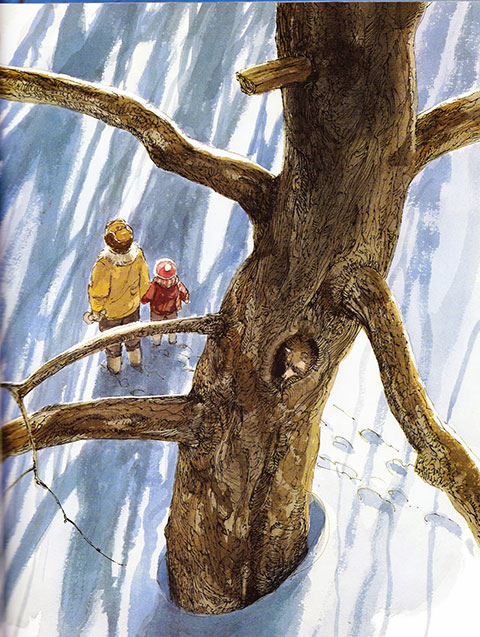
Written by Jane Yolen. Published by Philomel Books, 1987.
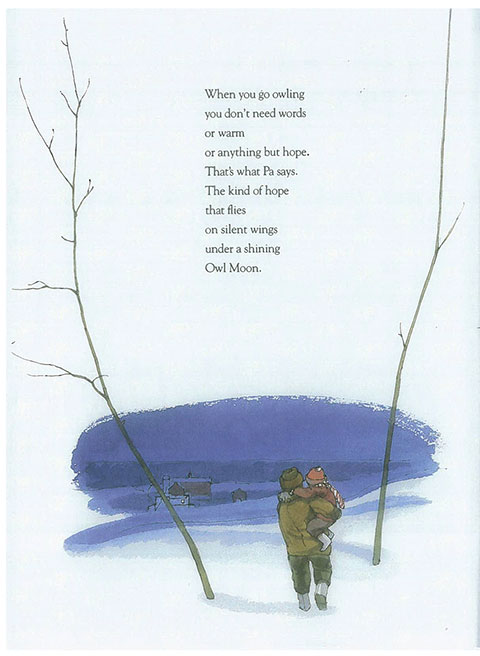
Written by Jane Yolen. Published by Philomel Books, 1987.
Each page turn brings a new visual perspective, from long views to close-ups, from bird’s eye to mouse view. This keeps the reader vigilant, scrutinizing the vistas for the elusive owl. The owl’s arrival is as astonishing to the readers as to the protagonists. The book concludes with a partial-page vignette of the child carried by the father as they embark upon a long nighttime walk home in the snow, “whiter than the milk in a cereal bowl.”
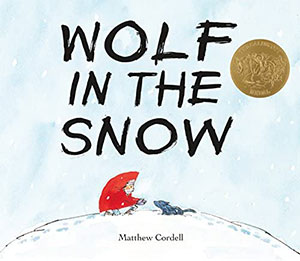 Another story of a walk in the snow is more ominous. Matthew Cordell’s Wolf in the Snow, the 2018 Caldecott Medal book, employs a “cold open”4 in which illustrations appear before the title page: In the first spread, a girl in a red hooded jacket leaves for school in the light snow; in the second, the girl continues her morning trek as a wolf pack of four adults and one pup are also on the move. When the story formally begins, the school day has ended and the snow is falling more heavily. Spreads alternate between the girl trudging towards the right and the wolves, and just the pup, walking towards the left. When girl meets pup, she decides to carry it over hills and through a forest to the howling pack. This Little Red Riding Hood’s encounter with wolves ends much differently than the traditional tale.
Another story of a walk in the snow is more ominous. Matthew Cordell’s Wolf in the Snow, the 2018 Caldecott Medal book, employs a “cold open”4 in which illustrations appear before the title page: In the first spread, a girl in a red hooded jacket leaves for school in the light snow; in the second, the girl continues her morning trek as a wolf pack of four adults and one pup are also on the move. When the story formally begins, the school day has ended and the snow is falling more heavily. Spreads alternate between the girl trudging towards the right and the wolves, and just the pup, walking towards the left. When girl meets pup, she decides to carry it over hills and through a forest to the howling pack. This Little Red Riding Hood’s encounter with wolves ends much differently than the traditional tale.
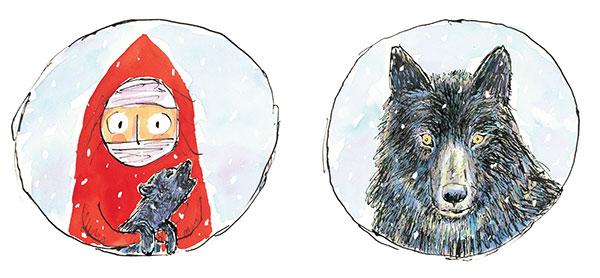
Wordless except for animal noises, the artwork drives the narrative in illustrations rendered in pen and ink with watercolor.5 To increase the suspense, Cordell draws “the human characters in my usual shorthand of line, and the wolves … much more realistically”6 He uses his “loose and expressive cartoon line[s]”7 for the barren hills and forbidding woods, gradually consumed with snow. Dabs of white paint connote thick and sometimes impenetrable snow.
Page design controls the pacing. Full-bleed double-page spreads focus on the exhausting journey; single-page spreads, some with panels, pick up the action; and concentric framed circles compel the reader to pause and observe. Finally, removing the book jacket reveals a surprise on the case cover, with vignettes of the girl and her family on the front, and of the pup and wolf pack on the back.
Buttoning up this overview of snow-inspired Caldecott books is The Snowy Day, also featuring a protagonist donning a red-hooded jacket like Cordell’s little girl. In the classic 1964 Caldecott Medal book, Peter wakes up to discover a blanket of snow covers his city neighborhood. Naturally, he heads outdoors for a day of adventure. Author-illustrator Ezra Jack Keats masterfully assembles bold collages, bringing color and texture to the full-bleed spreads. Keats’s materials include wallpaper, wrapping paper, Belgian canvas, oilcloth, and transparent paper, as well as unusual techniques with paint and stamps. “[C]ollage evokes an immediate sensory response,” reflects the artist. “Because of this quality it has special appeal for children, who experience the world in this immediate way.”8
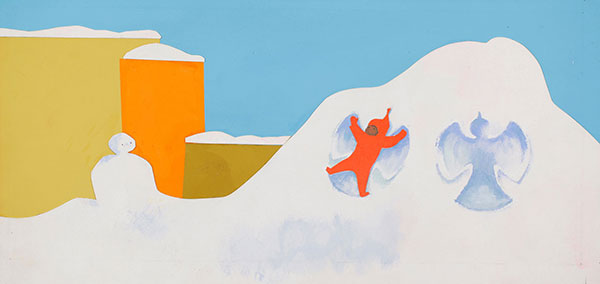
Published by Viking Books for Young Readers, 1962.
Through play and exploration, Peter expresses childlike curiosity, whether making footprints, a snowman, or snow angels. Bringing a snowball indoors “for tomorrow” leads to a melting disappointment, but the next day draws the boy outside again, this time with a friend.
Children’s literature specialists recognize The Snowy Day as “the first full-color picture book to feature a small black hero.”9 In deciding that Peter would be an African American child, Keats relates, “My book would have him there simply because he should have been there all along.”10
Author and editor Andrea Davis Pinkney was moved by the book as a child growing up in the 1960s: “[At] a time when I didn’t see others like me in children’s books, I was profoundly affected by the expressiveness of Keats’s illustrations,”11 leading her decades later to write A Poem for Peter: The Story of Ezra Jack Keats and the Creation of The Snowy Day.
These Caldecott award books depict the beauty (and, at times, ferocity) of snow in a range of styles and media. Alone, each book is a treasure. Enjoying two or more in one sitting, however, allows the reader to study how each illustrator captures the essence of snow, central to the setting, plot, and mood of these well-crafted works.
A cup of cocoa, anyone?
More Snowy Picture Books
Hader, Berta, and Elmer Hader. The Big Snow. New York: Macmillan, 1948 (1949 Caldecott Medal)
Tresselt, Alvin. White Snow, Bright Snow. Illustrated by Alvin Tresselt. New York: Lothrop, Lee & Shepard, 1947. (1948 Caldecott Medal)
Van Allsburg, Chris. The Polar Express. Boston: Houghton Mifflin, 1985. (1986 Caldecott Medal) Read more about this book in our article, “Transportation, Part II: Riding the Rails.”
Works Cited
Bentley, W. A., and W. J. Humphreys. Snow Crystals. New York: Dover, 1962.
Cordell, Matthew. Wolf in the Snow. New York: Feiwel and Friends/Macmillan, 2017.
Keats, Ezra Jack. The Snowy Day. New York: Viking, 1962.
Martin, Jacqueline Briggs. Snowflake Bentley. Illustrated by Mary Azarian. Boston: Houghton, 1998.
Pinkney, Andrea Davis. A Poem for Peter: The Story of Ezra Jack Keats and the Creation of The Snowy Day. Illustrated by Lou Fancher and Steve Johnson. New York: Viking, 2016.
Shulevitz, Uri. Snow. New York: Farrar Straus Giroux, 1998.
Yolen, Jane. Owl Moon. Illustrated by John Schoenherr. New York: Philomel, 1987.
Notes
- Jacqueline Briggs Martin, Snowflake Bentley, illustrated by Mary Azarian (Boston: Houghton, 1998).
- Association for Library Service to Children (ALSC), The Newbery & Caldecott Awards: A Guide to the Medal and Honor Books (Chicago: American Library Association, 2020), 117.
- ALSC, The Newbery & Caldecott Awards, 127.
- Lisa Bullard, “Matthew Cordell on the Complexities and Capabilities of Children,” Mackin Community, Mackin, 22 December 2021, .
- Matthew Cordell, Wolf in the Snow (New York: Feiwel and Friends/Macmillan, 2017).
- Matthew Cordell, “Wolf in the Snow,” Matthew Cordell Blogs, 3 October 2017.
- Matthew Cordell, “Wolf in the Snow.”
- Ezra Jack Keats, “Ezra Jack Keats on Collage as an Illustrative Medium,” Publishers Weekly 189, no. 14 (4 April 1966): 94 – 95.
- Selma G. Lanes, “Ezra Jack Keats: In Memoriam,” Horn Book Magazine 60, no. 5 (September/October 1984): 551 – 58.
- Brian Alderson, Ezra Jack Keats: Artist and Picture-Book Maker (Gretna, LA: Pelican, 1994), 51.
- Andrea Davis Pinkney, A Poem for Peter: The Story of Ezra Jack Keats and the Creation of The Snowy Day, illustrated by Lou Fancher and Steve Johnson (New York: Viking, 2016), 48.
Bibliography
Alderson, Brian. Ezra Jack Keats: Artist and Picture-Book Maker. Gretna, LA: Pelican, 1994.
Association for Library Service to Children (ALSC). The Newbery & Caldecott Awards: A Guide to the Medal and Honor Books. Chicago: American Library Association, 2020.
Bullard, Lisa. “Matthew Cordell on the Complexities and Capabilities of Children.” Mackin Community. Mackin, 22 December 2021.
Cordell, Matthew. Wolf in the Snow. New York: Feiwel and Friends/Macmillan, 2017.
Cordell, Matthew. “Wolf in the Snow.” Matthew Cordell Blogs, 3 October 2017.
Keats, Ezra Jack. “Ezra Jack Keats on Collage as an Illustrative Medium.” Publishers Weekly 189, no. 14 (4 April 1966): 94 – 95.
Lanes, Selma G. “Ezra Jack Keats: In Memoriam.” Horn Book Magazine 60, no. 5 (September/October 1984): 551 – 58.
Martin, Jacqueline Briggs. Snowflake Bentley. Illustrated by Mary Azarian. Boston: Houghton, 1998.
Pinkney, Andrea Davis. A Poem for Peter: The Story of Ezra Jack Keats and the Creation of The Snowy Day. Illustrated by Lou Fancher and Steve Johnson. New York: Viking, 2016.

